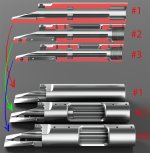M
MFG_BOP
Guest
Hi guys,
I need advises/critics/knowledge here on a dilemma I am living right now. I am about start making investment casting receivers
for either centerfire and rimfire. I would like to use the same mold for both of them (because of mold $$$).
I will try to be as short as possible with my question here and will elaborate further as the thread goes (if it goes).
Here they are:
- Would you make the mold with the extraction window, trigger slot, both abutments with its respective cams on so both types can come out of one mold and just different machinings?
- Should I focus on just one sort of action (with and without the above details)?
- Should I just make the mold to crank out the raw action #1 on image and then machine it accordingly?
- Should I forget about all that, pack my bags and go have a few days off in Australia w/ wife and son?
Mold is to make Rem 40-X benchrest actions type to use PTG bolts (again, both rimfire and centerfire).
Question here is not what the strongest actions is... cast or machined, but the details on the investment casting mold.
Image shows 3 actions with theirs respective cut outs. It was a MODO render of my Solidworks file.
I had once one Farley rough cast (no machining) and the only parts machined were the ramp on the back of the action and the main hole for the bolt.
I am asking here this question cos there are many smarter guys than I am out there and this site is a source of good people AND 2500X actions get here in New Zealand at the cost of NZ$ 3,000
Gotta say thanks for Wayne (lion) for his help!
Cheers guys!

I need advises/critics/knowledge here on a dilemma I am living right now. I am about start making investment casting receivers
for either centerfire and rimfire. I would like to use the same mold for both of them (because of mold $$$).
I will try to be as short as possible with my question here and will elaborate further as the thread goes (if it goes).
Here they are:
- Would you make the mold with the extraction window, trigger slot, both abutments with its respective cams on so both types can come out of one mold and just different machinings?
- Should I focus on just one sort of action (with and without the above details)?
- Should I just make the mold to crank out the raw action #1 on image and then machine it accordingly?
- Should I forget about all that, pack my bags and go have a few days off in Australia w/ wife and son?
Mold is to make Rem 40-X benchrest actions type to use PTG bolts (again, both rimfire and centerfire).
Question here is not what the strongest actions is... cast or machined, but the details on the investment casting mold.
Image shows 3 actions with theirs respective cut outs. It was a MODO render of my Solidworks file.
I had once one Farley rough cast (no machining) and the only parts machined were the ramp on the back of the action and the main hole for the bolt.
I am asking here this question cos there are many smarter guys than I am out there and this site is a source of good people AND 2500X actions get here in New Zealand at the cost of NZ$ 3,000
Gotta say thanks for Wayne (lion) for his help!
Cheers guys!


